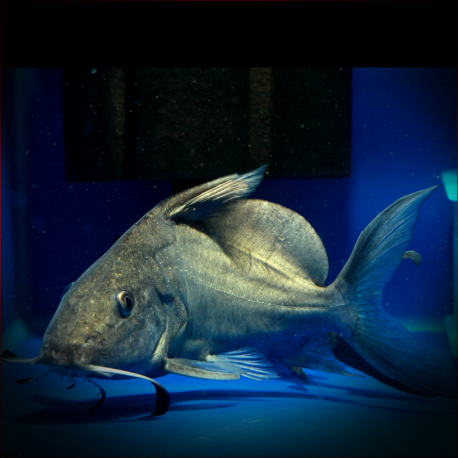More info
Datasheet
| Minimum Tank Size | 430 litres / 113.59 US gallons |
| Maximum Size | 50.0cm / 19.69inches |
| Temperature | 22°C / 71.60°F - 26°C / 78.80°F |
| Hardness | 5-15ºdH |
| pH | 6.5-7.5 |
General Description
Hemisynodontis membranaceus, commonly known as the Moustache Catfish, is a species that is the sole member of the genus Hemisynodontis. This fish presents unique morphological features such as additional gill rakers, a distinctive membrane on its maxillary barbels, and fewer mandibular teeth compared to the Synodontis species. It is primarily recognized for its comical appearance due to the membrane running along its maxillary barbels, resembling a moustache. Originally a filter feeder, this omnivorous species feeds on plankton and small invertebrates, displaying inverted feeding behavior at the water's surface. It is an ideal choice for larger community aquariums despite its juvenile spotty appearance fading with maturity.
Aquarium Setup
When setting up an aquarium for H. membranaceus, ensure a minimum tank size of 430 litres. Create a habitat mirroring its natural environment by incorporating soft substrate, rocks, driftwood, and twisted roots to form hiding spots. Additionally, include broad-leaved plants like Anubias or Echinodorus and floating vegetation to provide shelter, as this species tends to roost beneath them. Dim lighting is recommended to encourage visibility of the fish while maintaining water conditions within a pH range of 6.5-7.5, hardness of 5-15 dH, and a temperature of 22-26°C.
Behaviour
Initially social as juveniles, H. membranaceus tends to become territorial as it matures, especially towards conspecifics. Despite its peaceful demeanor towards other species of similar size, the intimidating bulk of adult specimens can scare off shy tankmates. This species may prey on very small fish, while larger Central and South American or African cichlids serve as suitable companions.
Feeding and Diet
The Moustache Catfish is an omnivore that readily accepts frozen, live, and dried foods. It also enjoys vegetable matter like shelled peas and cucumber and forages in its unique inverted style. Preferring smaller food items over larger meaty offerings such as prawns or mussels, this preference aligns with its natural filter feeding behavior focused on plankton consumption.
Reproduction & Dimorphism
Reproduction of H. membranaceus remains unrecorded in aquarium settings. Sexual dimorphism is observable in adults, with females appearing plumper than males. Distinguishing sexes can be challenging, requiring examination of the genital papillae, a task best left to experienced aquarists. Generally, females display a rounder papillae, while males have a pointed and ridged one, with distinct differences in the positioning of the oviducts and spermatoducts.
Habitat and Distribution
Inhabiting the deep shorelines of rivers and streams, Hemisynodontis membranaceus is found across a wide distribution range that includes Egypt, Nigeria, Gambia, Cameroon, Senegal, Chad, Malawi, Ghana, Niger, and Sudan.

